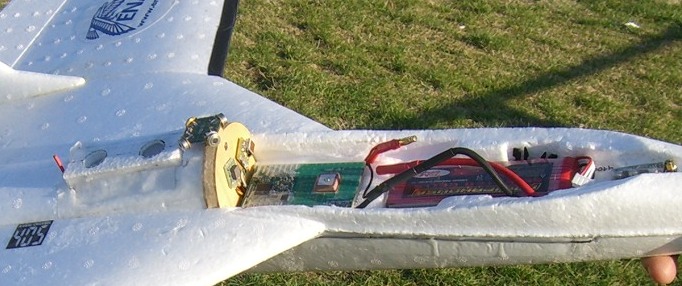Hardware Installation
Autopilot
The image below shows a Tiny V2 installed in a funjet. The dual IR sensor is also visible.

Sensors
Gyro
The gyro should be mounted with the PCB perpendicular to the X (roll) axis of the aircraft.
IR
The sensor FOV is typically around 60-100 deg, depending on brand. Everything emits heat, so you should try to keep the view as unobstructed as possible. There is of course no way to mount the sensors such that they are perfectly unobstructed and a complex set of calibration factors exist in the code to deal with this. Just be sure to keep any obstructions symmetrical, particularly difficult with pitch, and try to avoid having sun-heated surfaces in the FOV - such as the top of a wing, tail, or fuselage.
Avoid placing sensors in the exhaust stream since oil buildup will certainly cause trouble and you may even have problems with hot exhaust. It's important to note that you cannot cover the sensors with any commonly available material - only very special materials will allow LWIR to pass.
Most importantly, keep any video/data transmitters away from the sensors and their wires.
Dual IR
The mounting procedure of the Dual IR sensor is explained by the FMA CPD4 Manual on pages 6 and 7.
Slightly different installation and setup procedures are explained on page 23 of the CPD4 Manual. For planes which:
- Have a low or mid wing, and exhaust flows under fuselage.
- Have a canopy.
Single IR
Mount the single IR sensor so that it is vertical when the aircraft is in level flight, and has an unobstructed view of the sky and ground. Helicopter blades will not obstruct the sensor's view.
External GPS Antenna
Modems
The picture below shows a modem install on a funjet, and the Dual IR sensor.
General Electrical Advice
Wiring Suggestions
Common Ground
We had immediate success by connecting the motor chassis, the motor mounting bracket, the minus of the motor driver supply, the minus of the servo battery, the minus (ground) of the receivers onto a common ground wire which we laid through the whole plane body from tip to tail. Actually we use a braid from a shielded cable. Remove the insulation, then push the wire mesh shield ends together which makes it easy to slide off the cable, then pull to full lenght again. Finally the mesh was about 5 mm wide flat litz wire. Alternatively one could use thin copper tape which is available from electronics suppliers. High frequency currents run on the outer surface of the conductors, therefore it is important to have as much surface as possible on the ground wires. Connect each metal part to ground, e.g. motor mount.
Twisted Cables
Twisting is almost as good as shielding. Twisted cables normally do not have to be shielded in moderate environments. How does twisting work?
The electromagnetic field induces interference currents in the wires. By twisting the wires we change the polarity of the induced voltages every twist, and so the disturbances cancel each other.
It is absolute necessary to twist the power cables from the motor battery to the driver board, because there run high pulsed currents and what is true for reception, is also true for transmitting, and the electric noise transmitted from the power cable will cancel itself when run over twisted cables. Needless to say, make the wires as short as possible, from the battery to the driver to the motor. Those components must be placed as near as possible, especially the driver and the motor.
Always use twisted servo cables and remove those 3 pole flat cables from your design if possible!
Ground Loops
Grounding loops are not that much of concern as in audio equipment or in microvolt sensors, but there is a general simple rule to ground loops: avoid them.
Ferrite Beads
I do not recommend the use of ferrite beads, because if I need them, my basic design is flawed. Sometimes ferrites help to overcome problems, but I recommend to correctly design and install wirings and shields the proper way. For example, I would lay out the interior of a sensor compartment with thin copper foil or mesh or spray with conductive paint to get a shielded chamber. Of course, I must take care to connect all shields to ground on several places.
Preventing and Fixing Interference
All small-signal cables should be shielded, power cables twisted. Signal inputs should have small capacitors to ground for HF filtering, or an inductor + cap or a resistor + cap. Power cables must have HF capacitors on both ends! Electrolytic caps are not HF qualified. Cables could be connected via "feed through capacitors" and loaded with ferrite beads. Ground connections between the boards should be short and made of litz wires. Card cage should be lined with copper foil and connected to common ground on many places. And so on. Much to be tried out experimentally.
I would start to shield and filter the most sensitive circuitry. Find the point of maximal sensitivity. Switch off and on the various transmitters to identify the source.
Wrap the boards in thin copper sheet, and so on. Line the complete electronics compartment with thin copper and connect to ground. Put a conductive "ground plane" where the antennas are mounted. Adhesive copper shielding tape is available but you must put solder dots all over the tape joints. Conductive paint spray is also available. Create a HF "zero reference" plane where all ground connections meet. "Star" grounding configuration is less important to HF designs, but we must avoid wire loops.
